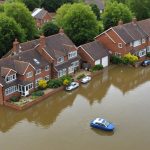Understanding Environmental Footprint in Property Development
In property development, the environmental footprint encompasses various components, including land use, resource consumption, and waste production. It quantifies the cumulative impact a development project has on the surrounding environment. Understanding these components is crucial as they directly affect ecosystems and resource availability.
Evaluating the environmental impacts in property developments is of paramount importance. It involves carefully assessing how construction, operation, and maintenance activities alter local landscapes. This evaluation allows developers to identify potential negative effects and implement strategies to minimise them, ensuring a more harmonious integration with natural systems.
Have you seen this : Navigating interest on arrears: a guide for borrowers
Sustainability in property development focuses on designing and building with an eye towards long-term ecological balance. In the context of the UK property market, this has become increasingly significant. Developers are challenged to innovate and adopt sustainable practices such as using renewable materials, enhancing energy efficiency, and reducing carbon emissions. These practices not only contribute to conserving resources but also elevate property value and tenant satisfaction.
By comprehensively addressing the environmental footprint, property developers contribute to a sustainable future, aligning construction efforts with global sustainability goals. These initiatives are not merely trends but essential frameworks shaping the evolution of the property market for years to come.
This might interest you : Mastering Global Marketing Strategies for UK Rental Properties: Attracting International Tenants with Ease
Regulatory Framework for Environmental Assessments in the UK
When examining UK legislation related to environmental regulations, it is crucial to understand the assessment frameworks that guide development projects. The cornerstone of this regulatory framework is the Environmental Impact Assessment (EIA) Regulations, which ensures that significant environmental effects are considered in public and private project decisions.
Key legislation includes the Town and Country Planning (Environmental Impact Assessment) Regulations, imposing obligations on developers to evaluate environmental consequences. Local authorities, under government policies, play a pivotal role in enforcing these regulations by scrutinizing development proposals and ensuring compliance with UK legislation.
Recent amendments, such as those incorporated in the 2017 EIA Regulation updates, align UK practices with key European Union directives, despite the post-Brexit landscape. Environmental regulations now feature expanded considerations, like climate change impacts and biodiversity objectives. These changes affect property developments substantially, requiring more detailed assessments and adherence to sustainability goals.
Local authorities also interpret and implement assessment frameworks, considering innovative solutions and sustainability within planning permissions. This dynamic landscape ensures that environmental considerations remain paramount in approving or rejecting development projects. As such, the ongoing evolution of UK legislation and directives will continue to have significant implications for developers and planners involved in environmentally sensitive areas.
Methodologies for Assessing Environmental Impact
In the realm of environmental impact assessment (EIA), understanding the methodologies employed is crucial for effective sustainability evaluation.
Overview of Environmental Impact Assessment (EIA)
Environmental Impact Assessment (EIA) is a process designed to evaluate the potential environmental consequences of proposed projects. It ensures that project planners consider environmental factors before commencing. EIA involves a systematic approach to identifying, predicting, and assessing the environmental effects of development proposals. Through well-structured reports, practitioners can determine the most sustainable practices to adopt.
Tools and Standards for Assessment
Multiple tools assist in the assessment methodologies for evaluating environmental impacts. Software tools and guidelines, like GaBi and SimaPro, offer robust platforms for gathering and analysing data relevant to environmental impacts. These tools provide frameworks aligned with international standards like ISO 14040, enhancing the reliability of sustainability evaluations. Such standards guide practitioners in ensuring consistency and accuracy in assessments.
Comparative Analysis of Methodologies Used in the UK
The UK showcases diverse assessment methodologies tailored to its unique environmental and regulatory landscape. The Bat Assessment Guidelines, for instance, highlight the importance of species-specific methodologies. Similarly, the use of the Green Star assessment considers broader sustainability evaluations. These methodologies emphasize the UK’s commitment to maintaining ecological integrity by evaluating strengths and weaknesses specific to the region’s needs.
Best Practices for Developers
Incorporating environmental assessments is crucial for property developers aiming at sustainable development. Conducting these assessments early in the planning process can help identify potential environmental impacts, ensuring that these factors are considered before any groundwork begins. This approach not only minimises negative effects but also aligns with best practices in sustainable development.
For sustainable development, selecting the right materials and designs is key. Developers should choose sustainable materials that have a lower environmental footprint. This includes using recycled or locally sourced materials that reduce transportation energy and emissions. Design features such as energy-efficient systems and green roofs can further enhance the sustainability of a property.
Effective engagement with stakeholders and the community is another best practice. Developers should involve these groups from the outset, keeping them informed and engaged throughout the project. This not only helps to build trust but can also provide valuable feedback that can improve the project’s sustainability. Tailoring designs and plans to address community needs ensures broader acceptance and success.
By integrating these best practices, property developers can achieve sustainable development that benefits not only their projects but also the wider community and environment. This multi-faceted approach supports long-term environmental, social, and economic gains.
Case Studies on Successful Environmental Evaluations
Exploring case studies on environmental assessments offers invaluable insights into the intricacies of sustainable development. Identifying the challenges and triumphs in various projects provides a framework for learning and future applications.
City A: Innovative Approaches in Property Development
In City A, one notable project demonstrated an innovative strategy in property development, focusing on reducing ecological impacts. This initiative prioritised green building techniques and renewable energy usage. The project, by incorporating sustainable materials and energy-efficient designs, not only met environmental regulations but also enhanced market appeal and project value.
City B: Overcoming Regulatory Challenges
Navigating regulatory landscapes remains a considerable hurdle in City B’s developments. A successful case here managed these challenges by engaging early with authorities, ensuring compliance through proactive dialogue. This approach allowed smoother project execution and provided a blueprint for others facing similar obstacles.
City C: Community Engagement Strategies
City C offers a compelling example of the power of community involvement in environmental projects. By actively involving stakeholders and ensuring transparent communication, projects here achieved greater acceptance and cooperation. Such strategies not only fostered community support but also triggered a sense of shared ownership and responsibility, crucial for long-term success.
Lessons learned from these case studies highlight the necessity of innovation, adherence to regulations, and community inclusion to achieve success in environmental evaluations.
Tools and Resources for Environmental Evaluations
Effective environmental evaluations require a combination of reliable evaluation tools, accessible resources, and comprehensive guidelines. Various software and platforms enhance the accuracy and efficiency of these assessments. These technological aids simplify data collection and analysis, allowing professionals to make informed decisions quickly.
Recommended Software and Platforms
- GIS (Geographic Information Systems): A powerful tool that permits spatial analysis and visualization of environmental data.
- LCA (Life Cycle Assessment) Software: Facilitates the understanding of environmental impacts from production to disposal stages.
These platforms integrate vast datasets, enabling users to evaluate multiple environmental aspects efficiently.
Guides and Handbooks
Property developers benefit significantly from guides tailored for their specific needs. These documents provide structured insights into the permits required, the impact of construction on biodiversity, and strategies for sustainable development.
University and Industry Resources
For ongoing learning, collaboration between academia and industry creates a rich repository of resources. Universities often offer courses and workshops focusing on updates in environmental regulations and cutting-edge evaluation methods. Furthermore, industry-led conferences and seminars provide a platform for sharing insights and innovative practices.
Access to these comprehensive tools and resources equips stakeholders with the knowledge to conduct thorough evaluations, fostering sustainability and compliance within environmental projects.
Expert Insights and Future Trends in Environmental Assessment
As we delve into the complexities of sustainability in development, it becomes essential to integrate expert opinions into our understanding of current practices. Sustainability experts highlight that, while progress has been made, there remains a significant gap in translating environmental assessment into impactful actions. They suggest enhancing collaboration across sectors and adopting more comprehensive evaluation methods to bridge this gap.
Emerging trends reveal a shift towards more dynamic and real-time approaches to environmental assessment. This includes the use of advanced data analytics and remote sensing technology to monitor ecological impacts continuously. Such innovations promise greater accuracy and adaptability, significantly enhancing our ability to respond to environmental changes swiftly and effectively.
Looking ahead, predictions underscore the influence of forthcoming climate policies on developmental strategies. Experts forecast that stricter regulations will drive a surge in green infrastructure projects and renewable energy investments. These policies are expected to compel industries to adopt sustainable practices more aggressively, emphasizing the importance of aligning development with environmental stewardship.
In summary, integrating future trends with expert insights provides a robust framework for advancing environmental strategies. This amalgamation is pivotal in navigating the challenges posed by climate change, ensuring that developmental strides align harmoniously with sustainability goals.












